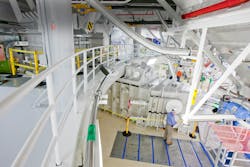INERTIAL-CONFINEMENT FUSION: 2014 laser fusion budgets: Rochester going up, Livermore down
Markups of the fiscal 2014 energy budget by the U.S. House and Senate Appropriations Committees provided only a small amount of good news for laser-fusion labs. The panels boosted funding for the Omega laser at the University of Rochester (Rochester, NY) from the Obama Administration’s proposed level-funding of $60 million to either $66 million or $67 million (an uncertainty that must be resolved later). But they let stand a $50 million cut in the National Nuclear Security Administration (NNSA) budget for the National Ignition Facility (NIF) at the Lawrence Livermore National Laboratory (Livermore, CA) to $329 million in 2014. The 2013 budget had been $379 million before sequesters. Office of Science funding for high-energy-density laboratory plasma experiments was also slashed.
The changes reflect reaction to NIF’s failure to achieve ignition by the target date, and an exceptionally tight budget. They will impact the future of inertial-confinement fusion and of Livermore, where NIF accounts for nearly 30% of the $1.1 billion budget expected in 2014.
The most-immediate impact will be on Livermore’s head count. On May 7, 2013, Livermore director Penrose Albright warned the Senate Armed Services Committee that the cuts “will significantly limit our ability to utilize the National Ignition Facility and [will] undermine the stewardship program.” The following day Livermore announced a voluntary severance program. Because most operating costs are personnel-related, the $50 million cut could cost hundreds of jobs. Livermore declined to respond to budget-related questions.
More than half of NIF laser shots now are devoted to weapons research for the Stockpile Stewardship program, which has always been NNSA’s main goal for the giant laser. Continuing research on inertial-confinement fusion also is important for the weapons program. “It’s important to understand which physics issues are in control” of target compression, says Dave Crandall, a former NNSA official who retired earlier this year after working on stockpile stewardship since 1995.
Lack of adequate scientific models of target compression and the diagnostics available to unravel the complex physics involved now limit the quest for ignition with NIF. “Their diagnostics are superb, better than anyone else has, but they are not adequate to the task in some ways,” says Crandall. He expects completion of the Advanced Radiographic Capability (see figure), a laser-based source of ultrashort x-ray pulses, to provide important help. Prospects for reaching ignition are far from exhausted, he adds, and the laser “works extremely well, but fusion is not that easily had.”
A National Research Council panel earlier this year said that progress in laser direct drive has made it “a plausible alternative to laser indirect drive for achieving ignition,” so the NIF program should expand to include direct drive and alternate modes.1 NNSA plans to continue exploring indirect, direct, and magnetic ignition, with a review of progress slated for the end of 2015. “Polar direct drive looks great technically, but you can’t guarantee it until you try it at NIF scale,” says Robert McCrory, director of Rochester’s Laboratory for Laser Energetics (LLE). Because direct drive requires reconfiguration of NIF optics, that would push the quest for ignition out to 2020 “if everything went like clockwork.” Symmetric direct drive has been tested on Omega, and should be even better, McCrory adds, but NIF can’t deliver uniform-enough illumination in its current configuration.
Bad news for LIFE and high-energy-density physics
The delay in reaching ignition “is not a crisis for stockpile stewardship, but it is a total crisis for people who think of energy applications,” says Crandall, who spent his last two years at the Department of Energy studying prospects for laser-fusion energy. “It doesn’t make sense to plan an energy program until we get to ignition.” He calls Livermore’s advocacy of the Laser Inertial Fusion Energy (LIFE) plan “a huge mistake” because it claimed that a diode-pumped megajoule-class laser could be firing several pulses per second to drive a prototype fusion reactor within a decade. “Over-promising did not play well with Congress.”
NIF-related cuts fall hardest on academic scientists studying high-energy-density laboratory plasmas. A pre-sequester 2013 budget of $25.3 million supported tests with high-peak-power lasers and other pulsed-power sources including the Z machine at Sandia National Laboratories (Albuquerque, NM). The fiscal 2014 budget slashes spending to $6.6 million, and most of the money will go for new equipment at the Linac Coherent Light Source at SLAC National Accelerator Laboratory (Menlo Park, CA).
“People in the field mostly have been working on OMEGA rather than NIF,” says Alec Thomas of the University of Michigan (Ann Arbor, MI), chair of the High Energy Density Science Association, which is protesting the cuts (OMEGA is the laser system at LLE). Although Livermore encourages science on NIF, few outside researchers have been given time on it.
Researchers had used the money to pay students and to access equipment. The proposed budget requires them to pay for operating costs, which are estimated at roughly $1 million per shot for NIF. “I can’t see that being feasible for the average academic or small business,” says Thomas. Yet NNSA’s fiscal 2014 budget request assumes that in future years “external users will use up to one-third of facility time and provide additional operational funding” for NIF.2
REFERENCES
1. An Assessment of the Prospects for Inertial Fusion Energy, The National Academies Press, Washington, DC, prepublication copy issued 20 Feb. 2013.
2. U.S. Department of Energy, FY2014 Congressional Budget Request: National Nuclear Security Administration, DOE/CF-0084. Vol. 1, April 2013, page WA-106.
About the Author
Jeff Hecht
Contributing Editor
Jeff Hecht is a regular contributing editor to Laser Focus World and has been covering the laser industry for 35 years. A prolific book author, Jeff's published works include “Understanding Fiber Optics,” “Understanding Lasers,” “The Laser Guidebook,” and “Beam Weapons: The Next Arms Race.” He also has written books on the histories of lasers and fiber optics, including “City of Light: The Story of Fiber Optics,” and “Beam: The Race to Make the Laser.” Find out more at jeffhecht.com.

